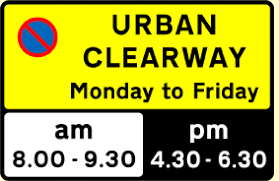Clearways are a vital part of road traffic management, designed to ensure the smooth flow of vehicles by restricting stopping during specified times. Understanding what a clearway is and when you can stop on one is crucial for all drivers to avoid penalties and contribute to efficient traffic movement. This blog will delve into the details of clearways, their importance, regulations, and exceptions.
1. Introduction
Clearways play a significant role in traffic management, particularly in busy urban areas. By prohibiting stopping and parking during peak hours, clearways help maintain traffic flow and reduce congestion. However, many drivers are unsure about the specifics of clearway regulations and when they are allowed to stop on one.

2. What Is a Clearway?
A clearway is a stretch of road where stopping and parking are prohibited during certain times, typically during peak traffic hours. This restriction is enforced to ensure that traffic moves smoothly and to prevent bottlenecks caused by parked or stopped vehicles. Clearways are usually marked by clearway signs, which indicate the times during which the restrictions apply.
3. Importance of Clearways
Clearways are essential for several reasons:
Reducing Traffic Congestion: By prohibiting stopping and parking during peak hours, clearways help reduce traffic congestion and ensure a smoother flow of vehicles.
Enhancing Road Safety: Clearways minimize the risk of accidents caused by vehicles stopping unexpectedly or obstructing the roadway.
Improving Public Transport Efficiency: Clearways often facilitate the movement of public transport, such as buses, by keeping lanes clear and reducing delays.
4. Clearway Signage
Clearway signs are typically rectangular with a red border and a blue circle featuring a red diagonal line. They indicate the times during which the clearway restrictions apply. It is crucial for drivers to pay attention to these signs and adhere to the indicated times to avoid penalties.
5. Regulations and Restrictions
Clearway regulations can vary depending on the location and type of road. There are generally two types of clearways: urban clearways and rural clearways.
Urban Clearways
Urban clearways are typically found in cities and towns, where traffic congestion is more prevalent. The restrictions usually apply during peak hours, such as morning and evening rush hours. For example, a clearway may be in effect from 7:00 AM to 9:00 AM and from 4:00 PM to 6:00 PM on weekdays.
Rural Clearways
Rural clearways are found on highways and major roads outside urban areas. These clearways aim to keep traffic moving smoothly on long stretches of road where stopping can cause significant disruptions. The restrictions may apply throughout the day or during specific times, depending on the road's traffic patterns.
6. Exceptions to Clearway Rules
While clearway rules are generally strict, there are some exceptions where stopping may be permitted:
Emergency Situations: You may stop on a clearway in an emergency, such as a vehicle breakdown or a medical emergency. Ensure that you move your vehicle to the side of the road as safely and quickly as possible.
Directed by Authorities: If directed by a police officer or other authorized personnel, you may stop on a clearway. Follow their instructions carefully.
Loading and Unloading: In some cases, clearway restrictions may allow for brief stops to load or unload passengers or goods. However, these exceptions are typically indicated by additional signage.
7. Penalties for Violating Clearway Rules
Failing to comply with clearway regulations can result in penalties, including fines and towing of your vehicle. The specific penalties vary depending on the location and severity of the violation. To avoid these consequences, always observe clearway signs and adhere to the restrictions.
8. Safety Tips for Driving on Clearways
Driving on clearways requires vigilance and adherence to traffic rules. Here are some safety tips to keep in mind:
Observe Signage: Always pay attention to clearway signs and follow the indicated restrictions.
Plan Ahead: If you need to stop, plan your journey to avoid clearway times and locations.
Stay Alert: Be aware of your surroundings and other vehicles, especially during peak hours.
Emergency Preparedness: In case of an emergency, move your vehicle to the side of the road as safely and quickly as possible.
9. Conclusion
Clearways are an essential aspect of road traffic management, helping to reduce congestion and enhance safety. Understanding what a clearway is and when you can stop on one is crucial for all drivers. By adhering to clearway regulations and being mindful of exceptions, you can contribute to a smoother and safer driving environment.
For further reading and to explore the sources of information, check out these links:
1. [Understanding Clearway Rules - Gov.UK] https://www.gov.uk/guidance/clearways-and-bus-lanes
2. [Clearway Signs and Regulations - RAC]
3. [Traffic Management: Clearways - NSW Governmen t]https://www.rms.nsw.gov.au/roads/using-roads/clearways.html
4. [Urban Clearways Explained - AA] https://www.theaa.com/driving-advice/legal/urban-clearways
5. [Road Safety and Clearways - Transport for London]
Understanding and respecting clearway regulations can significantly impact traffic flow and safety on our roads. By being informed and compliant, you play a crucial role in maintaining an efficient and safe driving environment.
